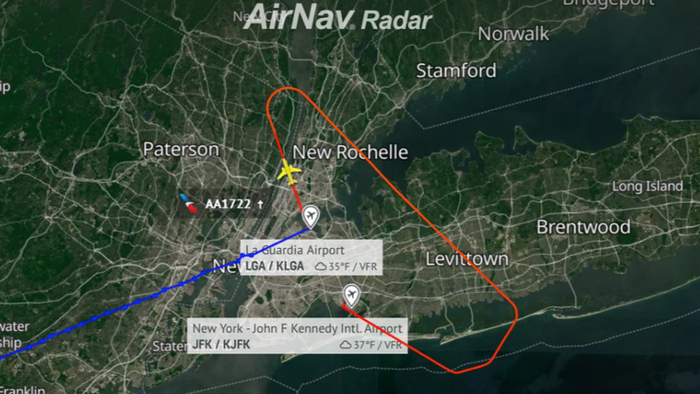An American Airlines flight, designated as AAL1722, encountered a serious incident shortly after its departure from LaGuardia Airport en route to Charlotte, North Carolina. On Thursday night, the aircraft was forced to make an emergency landing at John F. Kennedy International Airport due to what authorities initially termed a “bird strike.” This incident reportedly led to an engine fire; however, no injuries were reported among the 190 passengers or six crew members onboard. The rapid response and subsequent landing at JFK occurred minutes after the emergency was declared, demonstrating the effectiveness of the crew’s training under pressure.
Despite the official explanation that the engine fire was caused by a bird strike, the incident has ignited a debate, particularly in light of the ongoing reports of drone sightings across the New Jersey-New York City airspace. A video recorded by a passenger provided visual evidence of an object entering the engine, which some observers believe could be a drone rather than a bird. The Federal Aviation Administration (FAA) confirmed the object to be a bird, but this claim has not quelled speculation among aviation enthusiasts and skeptics alike.
Meteorologist John Basham, who weighed in on the discussion, noted his skepticism regarding the bird claim, stating that freeze frames from the footage appeared to show an object much larger than any bird. His observations prompted him to call for American Airlines to release images of the engine’s damage to validate the bird strike assertion. Basham emphasized that if it was indeed a bird strike, biological remnants should be present, which could effectively counter the notion that the object involved was a drone.
The incident comes at a time of heightened concern surrounding drone activity in the vicinity of major urban centers. Sightings have been reported sporadically, leading to a range of theories about their origin and purpose, from governmental surveillance operations to speculative narratives about psychological operations (psyops). As more outsiders share their interpretations and implications of such events, more questions arise about the regulation and management of aerial activities in crowded airspace.
The implications of mistakenly categorizing drone strikes as bird strikes raise critical safety concerns. With the rise of commercial and recreational drone usage, the potential for such unintended interactions with aircraft could have disastrous outcomes. The authority that governs air traffic is now confronted with the dual pressure of ensuring safe air travel while addressing the ambiguities surrounding the regulation of drone usage. Specifically, the increased accessibility of drones to hobbyists creates an environment where the risk of collisions with commercial airliners may become increasingly plausible.
As the investigation into this incident unfolds, aviation stakeholders, regulators, and the public alike are left grappling with the realities of air travel in an era that increasingly involves the convergence of traditional aviation and emerging technologies. Clear communication and transparency will be essential in addressing public concerns and rebuilding trust among passengers as they navigate the complexities of modern air travel. Continued vigilance will be necessary to ensure that safety protocols are adapted to this evolving landscape, where the line between a simple bird strike and the involvement of a drone becomes increasingly blurred.

